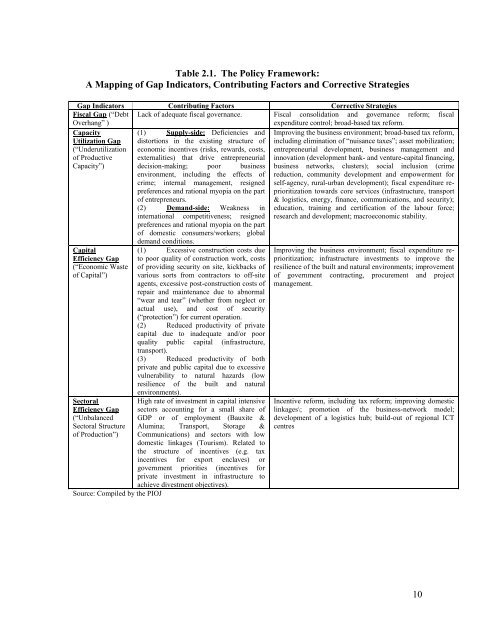PIOJ Growth-Inducement Strategy - Planning Institute of Jamaica
PIOJ Growth-Inducement Strategy - Planning Institute of Jamaica
PIOJ Growth-Inducement Strategy - Planning Institute of Jamaica
Create successful ePaper yourself
Turn your PDF publications into a flip-book with our unique Google optimized e-Paper software.
Table 2.1. The Policy Framework:<br />
A Mapping <strong>of</strong> Gap Indicators, Contributing Factors and Corrective Strategies<br />
Gap Indicators Contributing Factors Corrective Strategies<br />
Fiscal Gap (“Debt Lack <strong>of</strong> adequate fiscal governance. Fiscal consolidation and governance reform; fiscal<br />
Overhang” )<br />
expenditure control; broad-based tax reform.<br />
Capacity<br />
Utilization Gap<br />
(“Underutilization<br />
<strong>of</strong> Productive<br />
Capacity”)<br />
Capital<br />
Efficiency Gap<br />
(“Economic Waste<br />
<strong>of</strong> Capital”)<br />
Sectoral<br />
Efficiency Gap<br />
(“Unbalanced<br />
Sectoral Structure<br />
<strong>of</strong> Production”)<br />
Source: Compiled by the <strong>PIOJ</strong><br />
(1) Supply-side: Deficiencies and<br />
distortions in the existing structure <strong>of</strong><br />
economic incentives (risks, rewards, costs,<br />
externalities) that drive entrepreneurial<br />
decision-making; poor business<br />
environment, including the effects <strong>of</strong><br />
crime; internal management, resigned<br />
preferences and rational myopia on the part<br />
<strong>of</strong> entrepreneurs.<br />
(2) Demand-side: Weakness in<br />
international competitiveness; resigned<br />
preferences and rational myopia on the part<br />
<strong>of</strong> domestic consumers/workers; global<br />
demand conditions.<br />
(1) Excessive construction costs due<br />
to poor quality <strong>of</strong> construction work, costs<br />
<strong>of</strong> providing security on site, kickbacks <strong>of</strong><br />
various sorts from contractors to <strong>of</strong>f-site<br />
agents, excessive post-construction costs <strong>of</strong><br />
repair and maintenance due to abnormal<br />
“wear and tear” (whether from neglect or<br />
actual use), and cost <strong>of</strong> security<br />
(“protection”) for current operation.<br />
(2) Reduced productivity <strong>of</strong> private<br />
capital due to inadequate and/or poor<br />
quality public capital (infrastructure,<br />
transport).<br />
(3) Reduced productivity <strong>of</strong> both<br />
private and public capital due to excessive<br />
vulnerability to natural hazards (low<br />
resilience <strong>of</strong> the built and natural<br />
environments).<br />
High rate <strong>of</strong> investment in capital intensive<br />
sectors accounting for a small share <strong>of</strong><br />
GDP or <strong>of</strong> employment (Bauxite &<br />
Alumina; Transport, Storage &<br />
Communications) and sectors with low<br />
domestic linkages (Tourism). Related to<br />
the structure <strong>of</strong> incentives (e.g. tax<br />
incentives for export enclaves) or<br />
government priorities (incentives for<br />
private investment in infrastructure to<br />
achieve divestment objectives).<br />
Improving the business environment; broad-based tax reform,<br />
including elimination <strong>of</strong> “nuisance taxes”; asset mobilization;<br />
entrepreneurial development, business management and<br />
innovation (development bank- and venture-capital financing,<br />
business networks, clusters); social inclusion (crime<br />
reduction, community development and empowerment for<br />
self-agency, rural-urban development); fiscal expenditure reprioritization<br />
towards core services (infrastructure, transport<br />
& logistics, energy, finance, communications, and security);<br />
education, training and certification <strong>of</strong> the labour force;<br />
research and development; macroeconomic stability.<br />
Improving the business environment; fiscal expenditure reprioritization;<br />
infrastructure investments to improve the<br />
resilience <strong>of</strong> the built and natural environments; improvement<br />
<strong>of</strong> government contracting, procurement and project<br />
management.<br />
Incentive reform, including tax reform; improving domestic<br />
linkages\; promotion <strong>of</strong> the business-network model;<br />
development <strong>of</strong> a logistics hub; build-out <strong>of</strong> regional ICT<br />
centres<br />
10
















